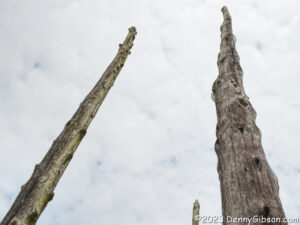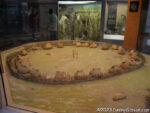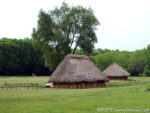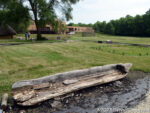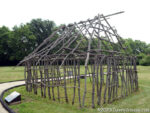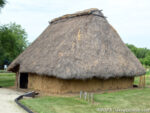There is a spot just a few miles southwest of Dayton, OH, where a village stood many centuries ago. Archeologists have determined that a cluster of tall posts stood near the center of the village and believe those posts were used in astronomical observations, especially observations involving our sun. Because of that, they call the site SunWatch Village.
There is now a museum at the site and a few of the village structures have been recreated. The outlines of others are marked by short posts where taller posts that were part of the structures once stood. The first picture at left is of a model inside the museum that is meant to represent the entire village. The second picture is of the actual site as seen from the large deck behind the museum. In the second picture, the tall poles can be seen just to the right of the skeleton building.
The northern hemisphere’s summer solstice, that instant when it hits its peak tilt toward the sun, occurred last Wednesday. Assuming that the scientists are correct about those poles, that would certainly have been a major event for SunWatch Village’s original inhabitants. It seems quite reasonable to think they might have held some sort of celebration to recognize the longest day of the year. Although no one lives there these days, there are people responsible for the site and they may very well have also wanted to celebrate the summer solstice when it happened but they couldn’t. Sadly, sometime in the last 800 or so years, somebody invented the work-week so most of our celebrating now gets put off until the weekend. Something called Summer Fest took place on Saturday, June 24, the third full day of summer. Summer solstice falls on a Friday next year so Summer Fest and the first full day of summer can align.
A level and well-graded path leads through the site with numerous signs explaining what you are looking at as well as providing some general archeological information.
Here is a closer look at the group of extra-tall poles. The original poles were charred at the base to help prevent decay and remove insects. That helped archeologists not only locate the poles but estimate their height. A sign at the hut across the way explains that the shadow of the tallest pole would fall on its hearth on the winter solstice.
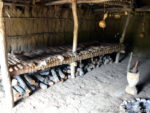

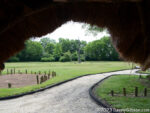 The interior of the thatched hut offers some idea of how it might have looked when occupied. The hearth’s alignment with the tall pole can also be seen from inside.
The interior of the thatched hut offers some idea of how it might have looked when occupied. The hearth’s alignment with the tall pole can also be seen from inside.

